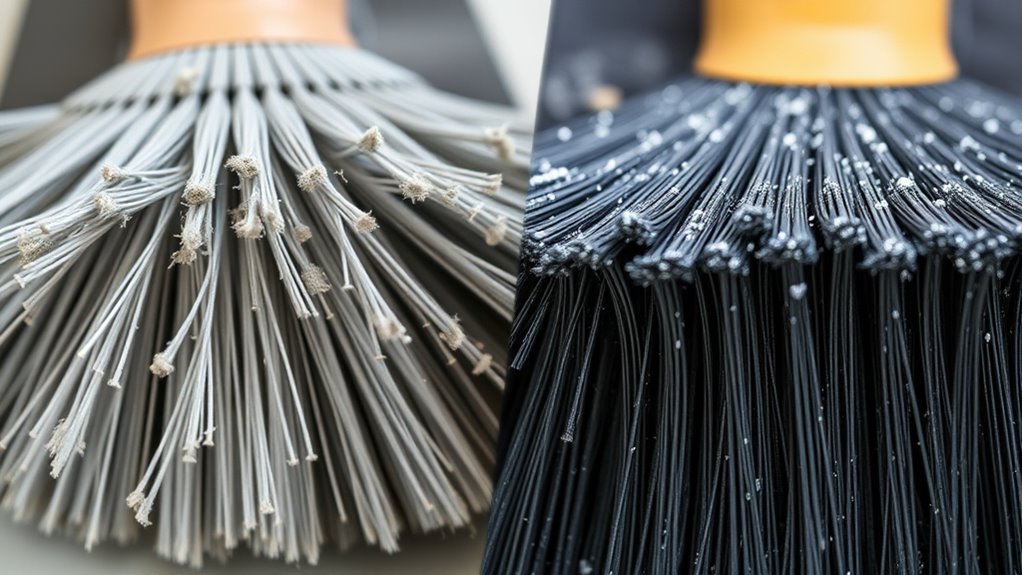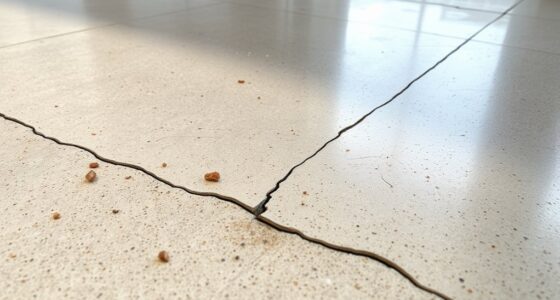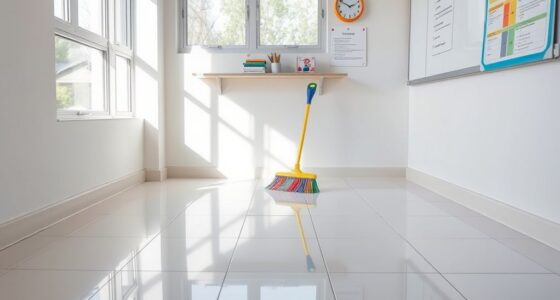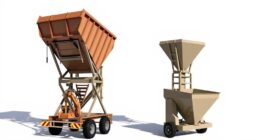To keep your sweeper brushes working well, check their condition regularly. Flip them when you notice uneven wear or frayed bristles on one side, as this doubles their lifespan and is cost-effective. Replace brushes when flipping no longer improves performance, or if they are worn past the point of flipping. Regular cleaning also helps. If you want tips on how to spot the right time to flip or replace, keep going for more helpful advice.
Key Takeaways
- Flip brushes when bristles are uneven, frayed, or worn to extend their lifespan cost-effectively.
- Replace brushes when flipping no longer restores effective cleaning or if bristles are significantly damaged.
- Regularly inspect for signs of wear like fraying, uneven height, or loss of rotation to determine maintenance needs.
- Consider manufacturer guidelines for replacement intervals, especially if brushes show signs of extensive wear.
- Keep brushes clean from debris and tangled materials to prevent premature wear and ensure proper function.

Have you ever wondered how sweeping up dirt and debris becomes so much easier? The secret often lies in your sweeper brushes. Proper maintenance can extend their lifespan and guarantee ideal cleaning performance. Knowing when to flip or replace your brushes is key, and understanding maintenance tips can help you make those decisions confidently. One of the first things to think about is the condition of the brushes. Regularly inspecting them for signs of wear, such as frayed bristles or uneven brush height, helps you catch issues early. If the brushes are unevenly worn, flipping them can be a simple fix. Many brushes are designed with two sides, allowing you to flip them over and use the other side before replacing. This can double their lifespan and save you money, but only if the brushes are still in good shape overall.
When it comes to maintenance tips, cleaning your brushes regularly is essential. Remove any tangled debris, hair, or stuck dirt that can hinder their movement and cleaning ability. Keeping the brushes clean prevents premature wear and guarantees they maintain good contact with surfaces. Additionally, check the brush material options. Brushes come in a variety of materials such as nylon, polypropylene, or natural fibers. Each material offers different benefits depending on your cleaning needs. For instance, nylon brushes are durable and flexible, suitable for general indoor use, while polypropylene brushes are resistant to chemicals and better for outdoor debris. Natural fiber brushes are gentle but effective for delicate surfaces. Choosing the right brush material can improve the lifespan and effectiveness of your sweeper. Remember that sound vibrations generated during use can also influence the efficiency and longevity of the brushes, especially when considering sound-absorbing or resonant properties of the materials.
Replacing brushes when they are worn beyond flipping is vital for maintaining cleaning efficiency. Worn brushes can leave debris behind, strain the motor, and cause uneven wear on your sweeper. It’s best to follow manufacturer guidelines for replacement intervals, but a good rule of thumb is to replace brushes if the bristles are significantly frayed or shortened, or if the brush no longer rotates smoothly. Regularly checking the condition of your brushes and following maintenance tips will keep your sweeper running smoothly. Remember, taking care of your brushes is not just about prolonging their life but also about achieving the best cleaning results every time. When in doubt, consult your sweeper’s manual or speak with a professional to guarantee you’re making the right call on flipping or replacing your brushes. Proper care ensures your sweeper remains an effective cleaning tool, saving you time and effort while keeping your space spotless.
Frequently Asked Questions
How Often Should I Flip My Sweeper Brushes?
You should flip your sweeper brushes every 1 to 3 months as part of regular brush maintenance. This helps guarantee even wear and extends their lifespan. Keep an eye on replacement frequency; if you notice the bristles are frayed or worn down, it’s time to replace the brushes entirely. Regularly flipping and replacing brushes keeps your sweeper working efficiently, saving you time and maintaining ideal cleaning performance.
What Signs Indicate My Brushes Need Replacing?
You should replace your sweeper brushes when you notice significant brush wear or bristle damage. If the bristles are frayed, bent, or missing, they won’t clean effectively. Additionally, if your sweeper struggles to pick up debris despite flipping the brushes, it’s a sign they’ve lost their shape and need replacement. Regularly inspect your brushes to catch these signs early and maintain peak cleaning performance.
Can I Clean Brushes Instead of Replacing Them?
Yes, you can clean brushes instead of replacing them. Use gentle cleaning techniques like removing debris with a brush comb or rinsing with warm water and mild soap. Regular brush maintenance helps prolong their life and keeps your sweeper functioning efficiently. Just be sure to thoroughly dry the brushes afterward to prevent any mold or damage. Proper cleaning can often restore brushes to good condition, saving you money and effort.
Are There Different Types of Brushes for Specific Floors?
Yes, there are different types of brushes for specific floors. You need to take into account floor compatibility and brush material to choose the right one. For hardwood, opt for softer brushes that won’t scratch; for carpets, go with stiffer bristles for better dirt removal. Matching your brush to your floor type ensures effective cleaning, protects your surface, and extends the life of your sweeper. Always check manufacturer recommendations for the best fit.
How Do I Choose the Right Replacement Brushes?
To choose the right replacement brushes, you should first consider the brush material, such as nylon or rubber, based on your flooring type. Check compatibility considerations like the brush size and connector style with your sweeper model. Always refer to the manufacturer’s guidelines to guarantee a proper fit. Picking the correct brush material and confirming compatibility will keep your sweeper effective and extend its lifespan.
Conclusion
To keep your sweeper working like new, remember to flip or replace your brushes when needed. Think of them as the unsung heroes of your cleaning routine—once they’re worn out, your floors suffer. Don’t let neglect be the villain in your spotless story. Regular upkeep isn’t just maintenance; it’s a small act of care that guarantees your sweeper remains a faithful partner in spotless success. After all, a clean home starts with clean brushes.








